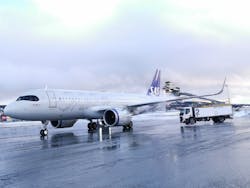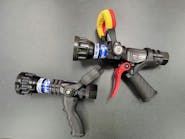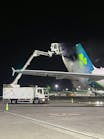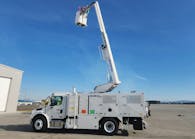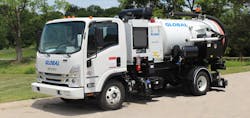The Arctic Elephant: Aviator Deicing Operations in Tromsø
The land above the Arctic Circle is an attractive destination for visitors from all over the globe. Tromsø, Norway, is famed for its midnight sun and the northern lights. These unique natural phenomenon attract adventurers from around the globe, seeking the challenges that the arctic offers and exploring the region’s scenic landscape of rugged coastlines, deep fjords, and towering mountains.
Rapid summers and long cold winters have become the expected weather cycles in Tromsø. The city usually experiences its first snow around October, with the blanket of white often remaining in place until the following May. With decades of experience in the European ground handling market, and as a full-range provider of aviation services at 15 airports across the Nordic region, Aviator expertly welcomes this annual challenge at its deicing station at Tromsø Airport.
Tromsø Airport
Due to a lack of rail services, Tromsø airport is a vitally important travel hub for both commuting workers and travelers alike. The airport is connected to a wide net of short field operations which average a runway length of 800 meters. To operate an aircraft in a polar environment, pilots require additional training, taking into account the rugged terrain around the airfields and their proximity to frigid seas. Life above the Arctic Circle creates many unique demands for its inhabitants. It is for these reasons that deicing and anti-icing procedures are imperative to maintaining a successful airline schedule throughout the course of the year.
“De- and anti-icing procedures are highly important to ensure the safety of an aircraft and thereby the safety of each individual flight,” says Truls Torgersen, Aviator ramp agent at Tromsø Airport. “An aircraft’s wings and rear tail components are shaped in a specific way to provide efficient lift for flight. Although rare, some deicing operations encounter a unique form of ice that clings onto the wing surfaces as a coat of clear ice. This phenomenon is almost imperceptible to the naked eye, hence, we tackle this through a tactical check (hands on the wing). Snow and ice on these areas can alter a wing’s shape and disrupt the airflow across its surface, hindering the ability to create proper lift.”
Having garnered the nickname “lookalike Norwegian Viking” in his duties as a ramp agent at TOS, Truls goes on to mention that a strong team and community culture, have become the foundation of the mechanisms set in place to cope with prolonged periods of winter darkness, ranging from minimal, to zero natural sunlight.
“With all this darkness you really need people to shine a light on you,” he adds.
The Arctic Elephant
Deicing and anti-icing procedures serve serval vitally important purposes.
Upon confirmation from the aircraft’s captain, all frozen or semi-frozen moisture on critical external surfaces of the aircraft are removed prior to flight. This process necessitates a follow-up procedure to further protect those cleaned surfaces from snow, ice, or frost contamination in the period between initial deicing treatment and the aircraft becoming airborne. Lastly, any frozen or semi-frozen moisture is removed from engine intakes while the fan blades and external surfaces are also protected accordingly.
So, how are all of these vitally important procedures conducted?
The deicing and anti-icing procedures require expert knowledge and experience as they incorporate human input through heavy machinery. The specialist machinery involved is the Elephant BETA-15 – affectionately known by the team as ‘The Arctic Elephant’. The Elephant BETA-15 has the longest reach capacity of any standard mobile deicer in the world, and is the heaviest handling equipment utilized by Aviator. The deicer can provide a working height of up to 15 meters, with an extending telescopic reach of 12 meters ensuring safe, efficient, and effective operation at all times.
The vehicle is equipped with three spacious tanks, which contain water and propylene glycol. The first tank contains hot water, the second contains heated Clariant safe wing MP1 eco plus 80 (type 1), and the last tank contains cold Clariant safe wing MP 2 flight (type 2). The onboard proportional mixing system blends the type 1 solution with the hot water for use in the first step of a two-step de/anti-icing procedure. The type 2 solution remains unmixed and is used in the second step of the two-step procedure. The fluid’s high viscosity maximizes the overall holdover time (the time between deicing and take off). Additionally, throughout the procedure, both type 1 (red) and type 2 (green) have different colorations, enabling the operator to differentiate between the fluids and ensure that the correct fluid is applied in each procedure.
A standard deicing procedures using two ‘Arctic Elephants’ – managed by deicing operators in a one- or two-step procedure – takes between 5 and 10 minutes.
“A one-step procedure is usually done during clear weather conditions and uses heated, diluted fluids to de-ice and anti-ice the aircraft in one step,” explains Truls Torgersen. “The two-step procedure, which gives the aircraft a longer holdover time depending on the severity of the snowfall and size of the aircraft, is accomplished in distinct and separate steps where the deicing and anti-icing treatments are conducted with thicker fluids to prolong the aircraft's protection from contamination. The first step removes the frozen contaminants, such as snow, frost, and ice using deicing fluid. The second step is the anti-icing - where the plane is treated with anti-icing fluids.”
The Midnight Sun
The incorporation of the Elephant BETA-15 into Aviator operations plays a significant role when winter temperatures ranging from minus 10 - 15 degrees are experienced. In some cases temperatures as low as minus 40 degrees are experienced further inland at another Aviator station located 130km from Tromso – Bardufoss Airport. The winter season in Bardufoss can bring far harsher conditions. As of March 2, the depth of snow measures 56cm, however, in November 2020, TOS recorded snow levels of up to 70 cm and the cumulative snowfall for the season measured in at 653cm. In 1997 the all-time record level for cumulative snowfall was measured at 750 cm. Locals describe this time as “a period where you don't see your neighbors houses anymore.” Airport staff share the same sentiment, as unattended handling equipment can easily be buried under heaps of snow only to be found the following spring.
After long months of active operations, Aviator’s “Arctic Elephants” finally get their well-deserved rest in May, although, it’s not unsual for the region to experience some snowfall during that time. However, as the machines get cleaned and maintained in preparation for the next season, Tromso and other cities in the Arctic Circle experience the natural phenomenon known as the “midnight sun”, where for approximately two months the sun never sets.
